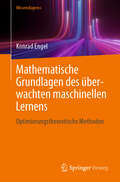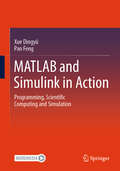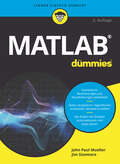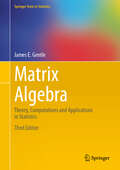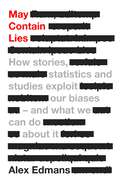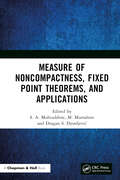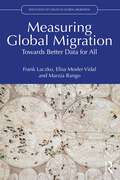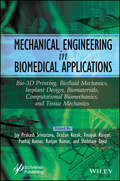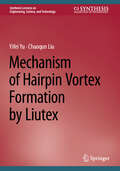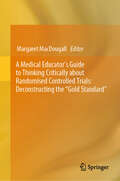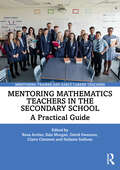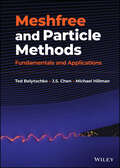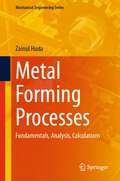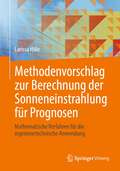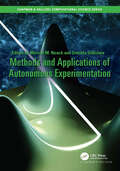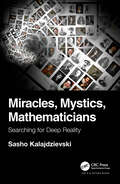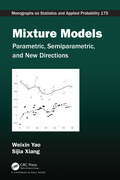- Table View
- List View
Mathematische Grundlagen des überwachten maschinellen Lernens: Optimierungstheoretische Methoden
by Konrad EngelDieses Buch behandelt die gängigsten Methoden zur Klassifikation von digitalisierten Objekten. Jedem Objekt ist ein Punkt im Euklidischen Raum passender Dimension zugeordnet. Das Lernen basiert auf einer Menge von Punkten, für die die zugehörige Klasse bekannt ist. Eine Reduktion der Dimension sowie elementare und anspruchsvollere Methoden zur Ermittlung schnell berechenbarer Funktionen, mit denen man aus einem Punkt die zugehörige Klasse mit einer möglichst geringen Fehlerrate ableiten kann, werden hergeleitet und in einer einheitlichen Herangehensweise begründet. Die recht elementaren Beweise werden im Wesentlichen mit Mitteln der Linearen Algebra geführt, nur für die neuronalen Netze wird etwas Analysis benötigt.Die Produktfamilie WissensExpress bietet Ihnen Lehr- und Lernbücher in kompakter Form. Die Bücher liefern schnell und verständlich fundiertes Wissen.
MATLAB and Simulink in Action: Programming, Scientific Computing and Simulation
by Dingyü Xue Feng PanThe textbook is intended for teaching MATLAB language and its applications. The book is composed of three parts: MATLAB programming, scientific computing with MATLAB, and system simulation with Simulink. Since MATLAB is widely used in all fields of science and engineering, a good introduction to the language can not only help students learn how to use it to solve practical problems, but also provide them with the skills to use MATLAB independently in their later courses and research. The three parts of the book are well-balanced and tailored to the needs of engineering students, and the mathematical problems commonly encountered in engineering can be easily solved using MATLAB. This textbook is suitable for undergraduate and graduate students majoring in science and engineering.
Matlab für Dummies (Für Dummies)
by Jim Sizemore John Paul MuellerMATLAB® So lernen Sie MATLAB ideal zu nutzen Ob Naturwissenschaftler, Mathematiker, Ingenieur oder Datenwissenschaftler - mit MATLAB haben Sie ein mächtiges Tool in der Hand, das Ihnen die Arbeit mit Ihren Daten erleichtert. Aber wie das mit manch mächtigen Dingen so ist - es ist auch ganz schön kompliziert. Aber keine Sorge! Die Autoren führen Sie in diesem Buch Schritt für Schritt an das Programm heran - von der Installation und den ersten Skripten bis hin zu aufwändigen Berechnungen, der Erstellung von Grafiken und effizienter Fehlerbehebung. Sie werden begeistert sein, was Sie mit MATLAB alles anstellen können. Sie erfahren Was es mit dem MATLAB-Dateisystem auf sich hat Wie Sie mathematische Operationen mit Vektoren und Matrizen durchführen Wie Sie Funktionen und Skripte erstellen Wie Sie importieren, exportieren und publizieren.
Matrix Algebra: Theory, Computations and Applications in Statistics (Springer Texts in Statistics)
by James E. GentleThis book presents the theory of matrix algebra for statistical applications, explores various types of matrices encountered in statistics, and covers numerical linear algebra. Matrix algebra is one of the most important areas of mathematics in data science and in statistical theory, and previous editions had essential updates and comprehensive coverage on critical topics in mathematics.This 3rd edition offers a self-contained description of relevant aspects of matrix algebra for applications in statistics. It begins with fundamental concepts of vectors and vector spaces; covers basic algebraic properties of matrices and analytic properties of vectors and matrices in multivariate calculus; and concludes with a discussion on operations on matrices, in solutions of linear systems and in eigenanalysis. It also includes discussions of the R software package, with numerous examples and exercises.Matrix Algebra considers various types of matrices encountered in statistics, such as projection matrices and positive definite matrices, and describes special properties of those matrices; as well as describing various applications of matrix theory in statistics, including linear models, multivariate analysis, and stochastic processes. It begins with a discussion of the basics of numerical computations and goes on to describe accurate and efficient algorithms for factoring matrices, how to solve linear systems of equations, and the extraction of eigenvalues and eigenvectors. It covers numerical linear algebra—one of the most important subjects in the field of statistical computing. The content includes greater emphases on R, and extensive coverage of statistical linear models. Matrix Algebra is ideal for graduate and advanced undergraduate students, or as a supplementary text for courses in linear models or multivariate statistics. It’s also ideal for use in a course in statistical computing, or as a supplementary text forvarious courses that emphasize computations.
May Contain Lies: How Stories, Statistics and Studies Exploit Our Biases - And What We Can Do About It
by Alex Edmans'A powerful and punchy explanation of why misinformation is a problem that affects us all - be that in finance, politics, media, business or anywhere else. Edmans offers clear ideas about how to counter this, not just in our own lives but also across society as a whole. Timely and very provocative!' - Gillian Tett, Editor-at-Large, Financial Times'Not only brilliantly researched and written but immensely practical' - Andy Haldane, former Chief Economist at the Bank of England'A timely book and, despite the nerdy statistical theories, is often quite funny' Harry Wallop, The TimesA ground-breaking book that reveals why our human biases affect the way we receive and interpret information, with practical suggestions for how to think more critically* Featured in Adam Grant’s 8 New Idea Books to Start Spring *Our lives are minefields of misinformation. Stories, statistics and studies lie to us on a daily basis. Not only this but, as Professor Alex Edmans reveals, our brains lie to us too. He argues that we need to acknowledge and understand the role that our own human biases play in interpreting and digesting the information that we consume. It's only when we do, that we can actively resist being manipulated, and make informed decisions that improve our lives.'A passionate and dispassionate call to truth – and how to achieve it - in a world of growing disinformation' – Will Hutton, author of The State We're In
Measure of Noncompactness, Fixed Point Theorems, and Applications
by S. A. Mohiuddine M. Mursaleen Dragan S. DjordjevićThe theory of the measure of noncompactness has proved its significance in various contexts, particularly in the study of fixed point theory, differential equations, functional equations, integral and integrodifferential equations, optimization, and others. This edited volume presents the recent developments in the theory of the measure of noncompactness and its applications in pure and applied mathematics. It discusses important topics such as measures of noncompactness in the space of regulated functions, application in nonlinear infinite systems of fractional differential equations, and coupled fixed point theorem.Key Highlights: Explains numerical solution of functional integral equation through coupled fixed point theorem, measure of noncompactness and iterative algorithm Showcases applications of the measure of noncompactness and Petryshyn’s fixed point theorem functional integral equations in Banach algebra Explores the existence of solutions of the implicit fractional integral equation via extension of the Darbo’s fixed point theorem Discusses best proximity point results using measure of noncompactness and its applications Includes solvability of some fractional differential equations in the holder space and their numerical treatment via measures of noncompactness This reference work is for scholars and academic researchers in pure and applied mathematics.
Measure of Noncompactness, Fixed Point Theorems, and Applications
The theory of the measure of noncompactness has proved its significance in various contexts, particularly in the study of fixed point theory, differential equations, functional equations, integral and integrodifferential equations, optimization, and others. This edited volume presents the recent developments in the theory of the measure of noncompactness and its applications in pure and applied mathematics. It discusses important topics such as measures of noncompactness in the space of regulated functions, application in nonlinear infinite systems of fractional differential equations, and coupled fixed point theorem.Key Highlights: Explains numerical solution of functional integral equation through coupled fixed point theorem, measure of noncompactness and iterative algorithm Showcases applications of the measure of noncompactness and Petryshyn’s fixed point theorem functional integral equations in Banach algebra Explores the existence of solutions of the implicit fractional integral equation via extension of the Darbo’s fixed point theorem Discusses best proximity point results using measure of noncompactness and its applications Includes solvability of some fractional differential equations in the holder space and their numerical treatment via measures of noncompactness This reference work is for scholars and academic researchers in pure and applied mathematics.
Measuring Global Migration: Towards Better Data for All (Routledge Key Issues in Global Migration)
by Frank Laczko Elisa Mosler Vidal Marzia RangoThis book focuses on how to improve the collection, analysis and responsible use of data on global migration and international mobility.While migration remains a topic of great policy interest for governments around the world, there is a serious lack of reliable, timely, disaggregated and comparable data on it, and often insufficient safeguards to protect migrants’ information. Meanwhile, vast amounts of data about the movement of people are being generated in real time due to new technologies, but these have not yet been fully captured and utilized by migration policymakers, who often do not have enough data to inform their policies and programmes. The lack of migration data has been internationally recognized; the Global Compact for Safe, Orderly and Regular Migration urges all countries to improve data on migration to ensure that policies and programmes are "evidence-based", but does not spell out how this could be done. This book examines both the technical data issues associated with improving data on migration and the wider political challenges of how countries manage the collection and use of migration data. The first part of the book discusses how much we really know about international migration based on existing data, and key concepts and approaches which are often used to measure migration. The second part of the book examines what measures could be taken to improve migration data, highlighting examples of good practice from around the world in recent years, across a range of different policy areas, such as health, climate change and sustainable development more broadly. Written by leading experts on international migration data, this book is the perfect guide for students, policymakers and practitioners looking to understand more about the existing evidence base on migration and what can be done to improve it.
Measuring Global Migration: Towards Better Data for All (Routledge Key Issues in Global Migration)
by Frank Laczko Elisa Mosler Vidal Marzia RangoThis book focuses on how to improve the collection, analysis and responsible use of data on global migration and international mobility.While migration remains a topic of great policy interest for governments around the world, there is a serious lack of reliable, timely, disaggregated and comparable data on it, and often insufficient safeguards to protect migrants’ information. Meanwhile, vast amounts of data about the movement of people are being generated in real time due to new technologies, but these have not yet been fully captured and utilized by migration policymakers, who often do not have enough data to inform their policies and programmes. The lack of migration data has been internationally recognized; the Global Compact for Safe, Orderly and Regular Migration urges all countries to improve data on migration to ensure that policies and programmes are "evidence-based", but does not spell out how this could be done. This book examines both the technical data issues associated with improving data on migration and the wider political challenges of how countries manage the collection and use of migration data. The first part of the book discusses how much we really know about international migration based on existing data, and key concepts and approaches which are often used to measure migration. The second part of the book examines what measures could be taken to improve migration data, highlighting examples of good practice from around the world in recent years, across a range of different policy areas, such as health, climate change and sustainable development more broadly. Written by leading experts on international migration data, this book is the perfect guide for students, policymakers and practitioners looking to understand more about the existing evidence base on migration and what can be done to improve it.
Mechanical Engineering in Biomedical Application: Bio-3D Printing, Biofluid Mechanics, Implant Design, Biomaterials, Computational Biomechanics, Tissue Mechanics
by Jay Prakash Srivastava Vinayak Ranjan Drazan Kozak Ranjan Kumar Pankaj Kumar Shubham TayalMECHANICAL ENGINEERING IN BIOMEDICAL APPLICATIONS The book explores the latest research and developments related to the interdisciplinary field of biomedical and mechanical engineering offering insights and perspectives on the research, key technologies, and mechanical engineering techniques used in biomedical applications. The book is divided into several sections that cover different aspects of mechanical engineering in biomedical research. The first section focuses on the role of additive manufacturing technologies, rehabilitation in healthcare applications, and artificial recreation of human organs. The section also covers the advances, risks, and challenges of bio 3D printing. The second section presents insight into biomaterials, including their properties, applications, and fabrication techniques. The section also covers the use of powder metallurgy methodology and techniques of biopolymer and bio-ceramic coatings on prosthetic implants. The third section covers biofluid mechanics, including the mechanics of fluid flow within our body, the mechanical aspects of human synovial fluids, and the design of medical devices for fluid flow applications. The section also covers the use of computational modeling to study the blockage of carotid arteries. The final section elaborates on soft robotic manipulation for use in medical sciences. Audience The book provides practical insights and applications for mechanical engineers, biomedical engineers, medical professionals, and researchers working on the design and development of biomedical devices and implants.
Mechanical Engineering in Biomedical Application: Bio-3D Printing, Biofluid Mechanics, Implant Design, Biomaterials, Computational Biomechanics, Tissue Mechanics
by Jay Prakash Srivastava Dražan Kozak Vinayak Ranjan Pankaj Kumar Ranjan Kumar Shubham TayalMECHANICAL ENGINEERING IN BIOMEDICAL APPLICATIONS The book explores the latest research and developments related to the interdisciplinary field of biomedical and mechanical engineering offering insights and perspectives on the research, key technologies, and mechanical engineering techniques used in biomedical applications. The book is divided into several sections that cover different aspects of mechanical engineering in biomedical research. The first section focuses on the role of additive manufacturing technologies, rehabilitation in healthcare applications, and artificial recreation of human organs. The section also covers the advances, risks, and challenges of bio 3D printing. The second section presents insight into biomaterials, including their properties, applications, and fabrication techniques. The section also covers the use of powder metallurgy methodology and techniques of biopolymer and bio-ceramic coatings on prosthetic implants. The third section covers biofluid mechanics, including the mechanics of fluid flow within our body, the mechanical aspects of human synovial fluids, and the design of medical devices for fluid flow applications. The section also covers the use of computational modeling to study the blockage of carotid arteries. The final section elaborates on soft robotic manipulation for use in medical sciences. Audience The book provides practical insights and applications for mechanical engineers, biomedical engineers, medical professionals, and researchers working on the design and development of biomedical devices and implants.
Mechanism of Hairpin Vortex Formation by Liutex (Synthesis Lectures on Engineering, Science, and Technology)
by Yifei Yu Chaoqun LiuThis book presents the importance of the mechanism of hairpin vortex formation to understanding flow transition, turbulence, and flow control. This book blends direct numerical simulation (DNS) and mathematical analysis with experiments to create a foundation for understanding turbulence. The authors discuss hairpin vortex as a main component of transitional flow and turbulent flow. In addition, Liutex is utilized and described as a theoretical system that presents valid tools for turbulence research. Readers are exposed to understanding 3D and non-linear instability; the Lambda vortex formation; sweeps, ejections, and shear instability; the Kelvin-Helmholtz instability and vortex ring formation; and turbulence generation and sustenance.
A Medical Educator's Guide to Thinking Critically about Randomised Controlled Trials: Deconstructing the "Gold Standard"
by Margaret MacDougallDrawing on the statistical and philosophical expertise of its authors, this book is designed to improve understanding and use of randomised controlled trials (RCTs) among health professionals. It is intended for use primarily by medical educators involved in teaching statistics and evidence-based medicine (EBM) to medical students, junior doctors and other health professionals. However, each of the chapters serves a wider range of interests, including the practical needs of physicians in interpreting research evidence to support clinical decision making and the teaching needs of philosophers of medicine who want to more fully appreciate how RCTs work in practice and provide engaging examples for their students. Rather than compete with the proliferating methodological literature on RCT designs, this book focuses on cultivating a healthy skepticism among developing health professionals to support critical appraisal of their own and published work on RCTs at a fundamental level, including through a more informed understanding of the place of subgroup analyses in sound statistical inference. Management of the positive predictive value in the statistical analysis of RCT findings is included as an important topic for contemporary medical curricula. In comparing RCTs with non-randomised studies, a search for empirical evidence for the superiority of RCTs is initiated, pointing to the need for further work to confirm what form this evidence should take.Medical educators will find a wealth of reasons to encourage their students to think more critically about how the RCT operates in practice as a gold standard.
Mentoring Mathematics Teachers in the Secondary School: A Practical Guide (Mentoring Trainee and Early Career Teachers)
by Rosa Archer Siân Morgan David Swanson Claire Clemmet Stef SullivanThis practical workbook assists school-based mentors of mathematics teachers to develop their mentoring skills, offering mentors the essential guidance needed in order to effectively support trainee or newly qualified secondary mathematics teachers, as well as in their overall career development. Offering tried and tested strategies based on research and evidence, Mentoring Mathematics Teachers in the Secondary School covers the knowledge, skills and understanding every mentor needs and offers practical tools such as lesson plans and feedback sheets, observation sheets, case studies, sample dialogues and other learning activities and exercises. Together with analytical tools for self-evaluation, this book is a vital source of support and inspiration for all those involved in developing the next generation of outstanding mathematics teachers, whether in teacher training or as newly qualified or early-career teachers. Key topics explored include: Roles and responsibilities of mentors within mathematics education, and understanding yourself as a mentor The mentor–mentee relationship, and helping develop a beginning teacher’s identity Supporting specific aspects of beginning mathematics teachers’ knowledge, skills and understanding, including developing reflective practice, lesson planning and mathematical misconceptions Strategies for observation and analysis of lessons, marking, assessment and the use of data Mentoring for long-term career and teacher development Filled with the key tools needed for the mentor’s individual development, Mentoring Mathematics Teachers in the Secondary School offers an accessible and practical guide to mentoring trainee teachers and early-career teachers with ready-to-use strategies that support, inspire and elevate both mentors and teachers alike. This book also includes an online eResource offering downloadable resources and web-based training material.
Mentoring Mathematics Teachers in the Secondary School: A Practical Guide (Mentoring Trainee and Early Career Teachers)
by Rosa Archer, Siân Morgan, David Swanson, Claire Clemmet and Stefanie SullivanThis practical workbook assists school-based mentors of mathematics teachers to develop their mentoring skills, offering mentors the essential guidance needed in order to effectively support trainee or newly qualified secondary mathematics teachers, as well as in their overall career development. Offering tried and tested strategies based on research and evidence, Mentoring Mathematics Teachers in the Secondary School covers the knowledge, skills and understanding every mentor needs and offers practical tools such as lesson plans and feedback sheets, observation sheets, case studies, sample dialogues and other learning activities and exercises. Together with analytical tools for self-evaluation, this book is a vital source of support and inspiration for all those involved in developing the next generation of outstanding mathematics teachers, whether in teacher training or as newly qualified or early-career teachers. Key topics explored include: Roles and responsibilities of mentors within mathematics education, and understanding yourself as a mentor The mentor–mentee relationship, and helping develop a beginning teacher’s identity Supporting specific aspects of beginning mathematics teachers’ knowledge, skills and understanding, including developing reflective practice, lesson planning and mathematical misconceptions Strategies for observation and analysis of lessons, marking, assessment and the use of data Mentoring for long-term career and teacher development Filled with the key tools needed for the mentor’s individual development, Mentoring Mathematics Teachers in the Secondary School offers an accessible and practical guide to mentoring trainee teachers and early-career teachers with ready-to-use strategies that support, inspire and elevate both mentors and teachers alike. This book also includes an online eResource offering downloadable resources and web-based training material.
Meshfree and Particle Methods: Fundamentals and Applications
by Ted Belytschko J. S. Chen Michael HillmanMeshfree and Particle Methods Provides thorough coverage of essential concepts and state-of-the-art developments in the field Meshfree and Particle Methods is the first book of its kind to combine comprehensive, up-to-date information on the fundamental theories and applications of meshfree methods with systematic guidance on practical coding implementation. Broad in scope and content, this unique volume provides readers with the knowledge necessary to perform research and solve challenging problems in nearly all fields of science and engineering using meshfree computational techniques. The authors provide detailed descriptions of essential issues in meshfree methods, as well as specific techniques to address them, while discussing a wide range of subjects and use cases. Topics include approximations in meshfree methods, nonlinear meshfree methods, essential boundary condition enforcement, quadrature in meshfree methods, strong form collocation methods, and more. Throughout the book, topics are integrated with descriptions of computer implementation and an open-source code (with a dedicated chapter for users) to illustrate the connection between the formulations discussed in the text and their real-world implementation and application. This authoritative resource: Explains the fundamentals of meshfree methods, their constructions, and their unique capabilities as compared to traditional methods Features an overview of the open-source meshfree code RKPM2D, including code and numerical examples Describes all the variational concepts required to solve scientific and engineering problems using meshfree methods such as Nitsche’s method and the Lagrange multiplier method Includes comprehensive reviews of essential boundary condition enforcement, quadrature in meshfree methods, and nonlinear aspects of meshfree analysis Discusses other Galerkin meshfree methods, strong form meshfree methods, and their comparisons Meshfree and Particle Methods: Fundamentals and Applications is the perfect introduction to meshfree methods for upper-level students in advanced numerical analysis courses, and is an invaluable reference for professionals in mechanical, aerospace, civil, and structural engineering, and related fields, who want to understand and apply these concepts directly, or effectively use commercial and other production meshfree and particle codes in their work.
Meshfree and Particle Methods: Fundamentals and Applications
by Ted Belytschko J. S. Chen Michael HillmanMeshfree and Particle Methods Provides thorough coverage of essential concepts and state-of-the-art developments in the field Meshfree and Particle Methods is the first book of its kind to combine comprehensive, up-to-date information on the fundamental theories and applications of meshfree methods with systematic guidance on practical coding implementation. Broad in scope and content, this unique volume provides readers with the knowledge necessary to perform research and solve challenging problems in nearly all fields of science and engineering using meshfree computational techniques. The authors provide detailed descriptions of essential issues in meshfree methods, as well as specific techniques to address them, while discussing a wide range of subjects and use cases. Topics include approximations in meshfree methods, nonlinear meshfree methods, essential boundary condition enforcement, quadrature in meshfree methods, strong form collocation methods, and more. Throughout the book, topics are integrated with descriptions of computer implementation and an open-source code (with a dedicated chapter for users) to illustrate the connection between the formulations discussed in the text and their real-world implementation and application. This authoritative resource: Explains the fundamentals of meshfree methods, their constructions, and their unique capabilities as compared to traditional methods Features an overview of the open-source meshfree code RKPM2D, including code and numerical examples Describes all the variational concepts required to solve scientific and engineering problems using meshfree methods such as Nitsche’s method and the Lagrange multiplier method Includes comprehensive reviews of essential boundary condition enforcement, quadrature in meshfree methods, and nonlinear aspects of meshfree analysis Discusses other Galerkin meshfree methods, strong form meshfree methods, and their comparisons Meshfree and Particle Methods: Fundamentals and Applications is the perfect introduction to meshfree methods for upper-level students in advanced numerical analysis courses, and is an invaluable reference for professionals in mechanical, aerospace, civil, and structural engineering, and related fields, who want to understand and apply these concepts directly, or effectively use commercial and other production meshfree and particle codes in their work.
Metal Forming Processes: Fundamentals, Analysis, Calculations (Mechanical Engineering Series)
by Zainul HudaThis unique textbook features fundamentals and analyses of metal forming processes supported by 200 worked numerical examples. It provides rigorous detail on the three all-important groups of metal-forming processes: bulk-metal forming, sheet-metal forming, and sheet-bulk-metal forming. Theory of metal forming is presented by discussing deformation behavior, plasticity, and formability with a thorough mathematical analyses and calculations. The mechanics of sheet metal forming is also covered by including principal strain increments in uniaxial loading as well as plane stress deformation. There are 125 diagrammatic illustrations/real-life photographs that have been labelled properly to enhance the understanding of readers. Among the salient features of the book is the inclusion of industrially-oriented projects, covering both technological and business considerations. The key solutions connected to these projects are presented with the aid of mathematical analysis and process flow diagrams. The book includes 100 multiple-choice questions (MCQs) with their answers and those for selected problems facilitating self-directed learning.
Methodenvorschlag zur Berechnung der Sonneneinstrahlung für Prognosen: Mathematische Verfahren für die ingenieurtechnische Anwendung
by Larissa HilleUm eine effiziente Nutzung erneuerbarer Energien zu ermöglichen, werden zuverlässige Prognosen für die Intensität der Sonneneinstrahlung benötigt. Im ersten Teil dieses Buchs wird eine neue, effiziente Methode für die Berechnung der diffusen Strahlung vorgestellt. Sie bestimmt die Intensität des gestreuten Lichts in einer Umgebung mit einer vertikal und horizontal variierenden Anzahldichte der streuenden Partikel. Die Methode kombiniert Monte-Carlo-Simulationen mit der Integralrechnung. Sie ermöglicht das Wiederverwenden berechneter Ergebnisse und erfordert bei einer vielfachen Anwendung einen geringen Rechenaufwand. Im zweiten Teil dieses Buchs wird eine einfache und genaue Methode zur Berechnung der Sonnenposition beschrieben. Die Methode basiert auf dem zweiten Keplerschen Gesetz und verwendet eine exakte trigonometrische Formel für die Fläche eines Ellipsensektors.
Methods and Applications of Autonomous Experimentation (Chapman & Hall/CRC Computational Science)
by Marcus M. Noack Daniela UshizimaAutonomous Experimentation is poised to revolutionize scientific experiments at advanced experimental facilities. Whereas previously, human experimenters were burdened with the laborious task of overseeing each measurement, recent advances in mathematics, machine learning and algorithms have alleviated this burden by enabling automated and intelligent decision-making, minimizing the need for human interference. Illustrating theoretical foundations and incorporating practitioners’ first-hand experiences, this book is a practical guide to successful Autonomous Experimentation. Despite the field’s growing potential, there exists numerous myths and misconceptions surrounding Autonomous Experimentation. Combining insights from theorists, machine-learning engineers and applied scientists, this book aims to lay the foundation for future research and widespread adoption within the scientific community. This book is particularly useful for members of the scientific community looking to improve their research methods but also contains additional insights for students and industry professionals interested in the future of the field.
Methods and Applications of Autonomous Experimentation (Chapman & Hall/CRC Computational Science)
Autonomous Experimentation is poised to revolutionize scientific experiments at advanced experimental facilities. Whereas previously, human experimenters were burdened with the laborious task of overseeing each measurement, recent advances in mathematics, machine learning and algorithms have alleviated this burden by enabling automated and intelligent decision-making, minimizing the need for human interference. Illustrating theoretical foundations and incorporating practitioners’ first-hand experiences, this book is a practical guide to successful Autonomous Experimentation. Despite the field’s growing potential, there exists numerous myths and misconceptions surrounding Autonomous Experimentation. Combining insights from theorists, machine-learning engineers and applied scientists, this book aims to lay the foundation for future research and widespread adoption within the scientific community. This book is particularly useful for members of the scientific community looking to improve their research methods but also contains additional insights for students and industry professionals interested in the future of the field.
Miracles, Mystics, Mathematicians: Searching for Deep Reality
by Sasho KalajdzievskiMiracles, Mystics, Mathematicians: Searching for Deep Reality focuses on the lives and writings of some of history’s most influential mathematicians and the impact that their mystical beliefs had on their lives and on their mathematical work. Modern biographers often cleanse the lives of renowned scientists of any hint of mysticism or occultism. Such threads are sometimes regarded as relics of the superstitious past; flaws that need to be hushed up, marginalized, or reinterpreted. This book represents a minor attempt to push back against this tendency and to examine these aspects of the history of mathematics with seriousness and intellectual curiosity. Features A breadth of scope covering many centuries Suitable for anyone interested in mathematics, history, philosophy, paranormal phenomena, psi-research, mysticism, or in any combination of the above An almost unique account of known histories, examined from a new vantage point Sasho Kalajdzievski is a Senior Scholar in the Department of Mathematics at the University of Manitoba.
Miracles, Mystics, Mathematicians: Searching for Deep Reality
by Sasho KalajdzievskiMiracles, Mystics, Mathematicians: Searching for Deep Reality focuses on the lives and writings of some of history’s most influential mathematicians and the impact that their mystical beliefs had on their lives and on their mathematical work. Modern biographers often cleanse the lives of renowned scientists of any hint of mysticism or occultism. Such threads are sometimes regarded as relics of the superstitious past; flaws that need to be hushed up, marginalized, or reinterpreted. This book represents a minor attempt to push back against this tendency and to examine these aspects of the history of mathematics with seriousness and intellectual curiosity. Features A breadth of scope covering many centuries Suitable for anyone interested in mathematics, history, philosophy, paranormal phenomena, psi-research, mysticism, or in any combination of the above An almost unique account of known histories, examined from a new vantage point Sasho Kalajdzievski is a Senior Scholar in the Department of Mathematics at the University of Manitoba.
Mixture Models: Parametric, Semiparametric, and New Directions (ISSN)
by Weixin Yao Sijia XiangMixture models are a powerful tool for analyzing complex and heterogeneous datasets across many scientific fields, from finance to genomics. Mixture Models: Parametric, Semiparametric, and New Directions provides an up-to-date introduction to these models, their recent developments, and their implementation using R. It fills a gap in the literature by covering not only the basics of finite mixture models, but also recent developments such as semiparametric extensions, robust modeling, label switching, and high-dimensional modeling. Features Comprehensive overview of the methods and applications of mixture models Key topics include hypothesis testing, model selection, estimation methods, and Bayesian approaches Recent developments, such as semiparametric extensions, robust modeling, label switching, and high-dimensional modeling Examples and case studies from such fields as astronomy, biology, genomics, economics, finance, medicine, engineering, and sociology Integrated R code for many of the models, with code and data available in the R Package MixSemiRob Mixture Models: Parametric, Semiparametric, and New Directions is a valuable resource for researchers and postgraduate students from statistics, biostatistics, and other fields. It could be used as a textbook for a course on model-based clustering methods, and as a supplementary text for courses on data mining, semiparametric modeling, and high-dimensional data analysis.
Mixture Models: Parametric, Semiparametric, and New Directions (ISSN)
by Weixin Yao Sijia XiangMixture models are a powerful tool for analyzing complex and heterogeneous datasets across many scientific fields, from finance to genomics. Mixture Models: Parametric, Semiparametric, and New Directions provides an up-to-date introduction to these models, their recent developments, and their implementation using R. It fills a gap in the literature by covering not only the basics of finite mixture models, but also recent developments such as semiparametric extensions, robust modeling, label switching, and high-dimensional modeling. Features Comprehensive overview of the methods and applications of mixture models Key topics include hypothesis testing, model selection, estimation methods, and Bayesian approaches Recent developments, such as semiparametric extensions, robust modeling, label switching, and high-dimensional modeling Examples and case studies from such fields as astronomy, biology, genomics, economics, finance, medicine, engineering, and sociology Integrated R code for many of the models, with code and data available in the R Package MixSemiRob Mixture Models: Parametric, Semiparametric, and New Directions is a valuable resource for researchers and postgraduate students from statistics, biostatistics, and other fields. It could be used as a textbook for a course on model-based clustering methods, and as a supplementary text for courses on data mining, semiparametric modeling, and high-dimensional data analysis.
